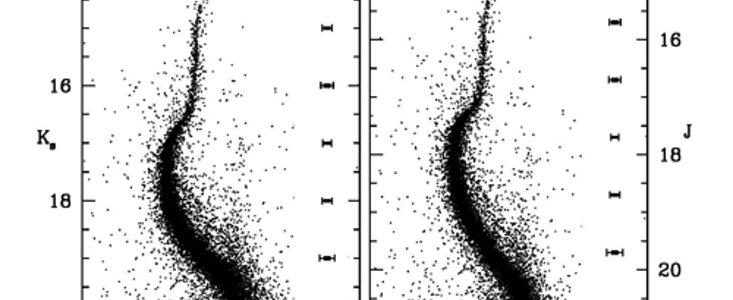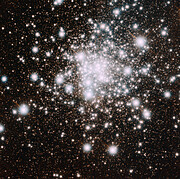Cluster’s Advanced Age in Razor-sharp Focus
12 Octubre 2016
An international team of astronomers, using the Gemini Multi-conjugate adaptive optics System (GeMS) and the high resolution camera GSAOI, brought the ancient globular cluster NGC 6624 into razor-sharp focus and determined its age with very high accuracy - a challenging observation even from space. In addition to producing a beautiful image, this work ultimately helps astronomers to better understand the formation and evolution of our Galaxy during its earliest development when the Universe was less than two billion years old.
Researchers using advanced adaptive optics technology at the Gemini South telescope in Chile probed the depths of the highly compact globular cluster NGC 6624, revealing pinpoint images of thousands of stars. The sharpness of the near-infrared images is competitive with that obtained from space with the Hubble Space Telescope in optical light. “With images this sharp, astronomers can do things that we never dreamed were possible from the ground,” says team member Douglas Geisler of the University of Concepción in Chile.
The team obtained the imaging data using two filters that are sensitive to specific wavelength bands of near-infrared light, then plotted them on a color-magnitude diagram – a technique that reveals details about the evolutionary history of the cluster’s stars. According to first author Sara Saracino from the University of Bologna, this is the most accurate, and deepest, near-infrared color-magnitude diagram ever produced of this cluster and indeed perhaps the best-ever made for any bulge cluster. The results of this research will be published in The Astrophysical Journal. A preprint of the paper can be found here.
The observations provide a clear detection of the so-called “main-sequence knee,” a distinctive bend in the evolutionary track of low mass main-sequence stars (those that burn hydrogen into helium at their cores). This feature is extremely faint and therefore difficult to detect, requiring very precise photometry (measuring the brightness of individual stars). Photometry is generally a problem with most adaptive optics data.
This is the first time the main-sequence knee has been identified in this globular cluster. “Analysis of these razor-sharp images, and the very deep color-magnitude diagram, allows us to determine the age of the cluster to extremely high precision,” says Saracino. In turn, this helps to better understand the formation and evolution of our Milky Way bulge, which may well be the oldest component of the Galaxy. The new Gemini data reveal that the age of NGC 6624 is between 11.5-12.5 billion years old, almost as old as the Universe itself - estimated to be about 13.8 billion years old.
NGC 6624 is also interesting because it has been classified as what astronomers call a post-core collapse cluster, meaning that this is a highly evolved system. The high quality of the data also allowed the researchers to perform a detailed study of the distribution of main-sequence stars of different masses outward from the center. As expected for such a highly evolved system, the team found evidence of a significant increase in low-mass stars at increasing distances from the cluster center.
This study is part of a much larger research program aimed at shedding new light on the still debated processes that formed the Milky Way’s bulge using its globular cluster population. Due to the large amount of absorption by material between the stars in the Milky Way Galaxy, detailed studies of bulge globular clusters have been severely hampered until now. Geisler notes that the advent of the GeMS instrument now allows astronomers to penetrate the dust and study these clusters in the great detail they deserve. “It will certainly continue to provide us with very important clues about how our Galaxy formed and evolved,” he says.
The Gemini Multi-conjugate adaptive optics System (GeMS), combined with the Gemini South Adaptive Optics Imager (GSAOI), delivers near diffraction-limited images of near-infrared light (0.9-2.5 microns), over a field nearly as large as the Hubble Space Telescope’s Wide Field Camera 3 (WFC3). Using five artificial laser guide stars, and up to three natural guide stars, GeMS/GSAOI can correct for atmospheric turbulence at an unprecedented level, making it the most powerful wide-field adaptive optics system currently available to astronomers.
Contactos
Sara Saracino
Department of Physics and Astronomy University of Bologna
Bologna, Italy
Tel: +39 051 2095788
Cel: +39 3201607913
Correo electrónico: sara.saracino@unibo.it
Douglas Geisler
Departamento de Astronomia Universidad de Concepción
Concepción, Chile
Tel: +56-41-2203092
Cel: +56-9-93078848
Correo electrónico: dgeisler@astroudec.cl
Peter Michaud
Gemini Observatory
Hilo, Hawai‘i
Cel: 808 936-6643
Correo electrónico: pmichaud@gemini.edu
Manuel Paredes
Gemini Observatory
La Serena, Chile
Tel: +56 (51) 2205671
Correo electrónico: mparedes@gemini.edu
About the Release
| Release No.: | gemini1609 |
| Nombre: | NGC 6624 |
| Facility: | Gemini South |
| Instruments: | GeMS, GSAOI |
| Science data: | 2017NatPh..13..276C |



